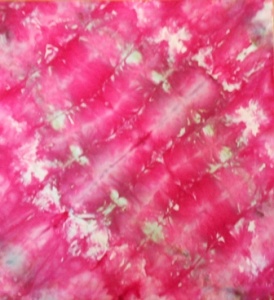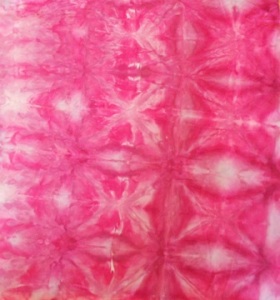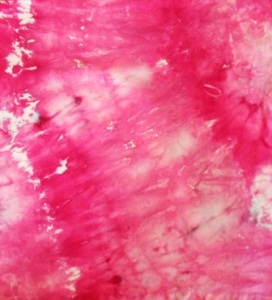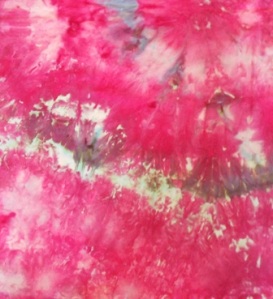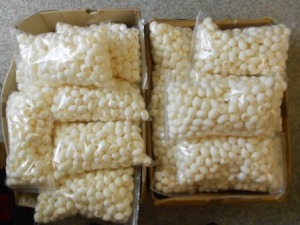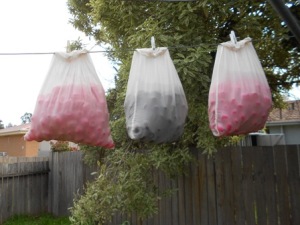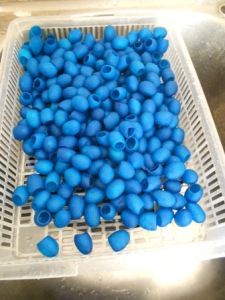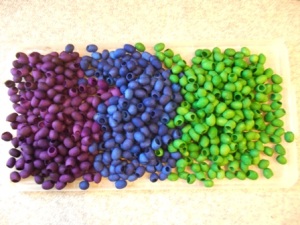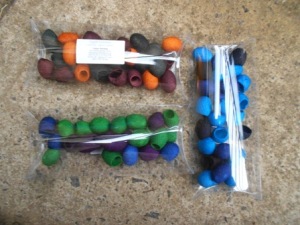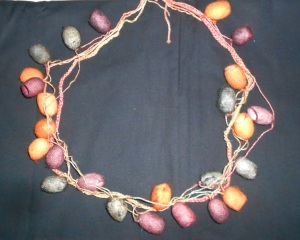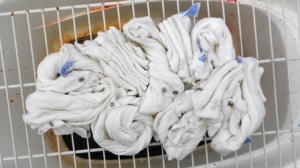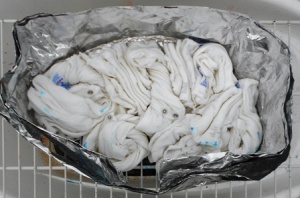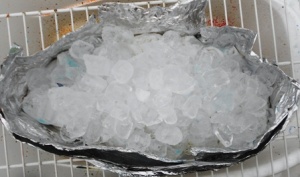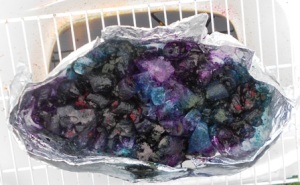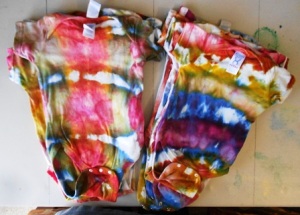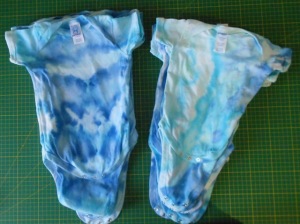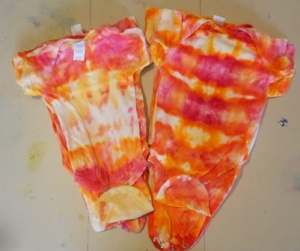I get a lot of questions on what the different types of silk products are that I dye, so this blog post is to explain, very briefly the different types I use and where they come from in the silk making process. Many are bi-products or part of the silk spinning process. Others are not.
Firstly lets look at the two types of silk fibre.
There are two, quite different, silk fibres – Mulberry or Tussah. I did a blog post on these in the past which you can find here: https://uniquestitching.wordpress.com/category/silks/. In both cases, the silk worms eat different leaves. Mulberry, which is sometimes refered to as Bombyx fibre, comes from the worm eating the leaves of the mulberry plant. Tussah silk is made when the worm eats oak leaves.
The Tussah is matte, honey coloured and a bit coarser.

The Mulberry silk is fine, cream in colour and very lustrous.

Both dye up beautifully, but put in the same dye bath, will have a different finish. This is the Rose Petal colour way. Both bits of silk below are 25grams. The one on the left is Tussah, the one on the right is Mulberry. They were dyed at exactly the same time in the same dye bath.

Silk fibre or silk top, whether Tussah or Mulberry can be teased out, spun, made into silk paper, couched down, trapped behind net, felted into wet felt with wool, needlefelted and so much more. Silk top is made by boiling down the cocoons to break down the protein that makes them hard (sericin). Once boiled down, the individual strands are pulled out and run through machines or by hand to collect the fibre.
Swapping colourways to my Pretty in Pink colourway now, I am going to show you some of the more interesting bits of silk.
One of my favourites is the Throwsters Waste. It is a crinkly, textural fibre. Basically it comes from cocoons that are flawed so that the fibre is not straight and can’t be woven into fabric. It keeps its interesting texture when you felt, needlefelt or bond it. Throwsters adds terrific texture to silk paper or when stitched onto a surface.

Still in the ‘soft’ fibres are two that are similar – hankies or caps. Now neither of these are clothing items. They are sometimes called mawata silk caps or mawata silk hankies. Mawata is a Japanese term describing this material. The Caps and Hankies are made by taking cocoons that have been boiled to remove the sericin like the fibre or tops. However instead of lifting the individual strands of silk and pulling it out, the cocoon is taken and stretched across a frame. In the case of the hankies, it is a square frame about 20 to 30 cms square. With the caps, the cocoons are stretched over a arch type of frame. In both cases, the silk stretches out and builds into layers which can be used as a solid, lightly bonded silk fabric or can be pulled apart into individual cocoon amounts of silk, like cob webs.

one silk cap

a bundle of silk hankies
I can never determine what ‘one silk hankie’ is, so I sell them in 10gram bundles. Here is some of the hankie, seperated out. You can see the white paper behind the silk. This is the weight that the spinners bring these to and then ‘draft’ the hankie or pull it out to a long piece of stretched fibre that they then spin.

I use hankies and caps as backgrounds to embellish or stitch into, as pieces of fabric to stitch onto things, to needle felt or, when pulled apart silk paper or very fine fabric to gather, scrunch and add as texture.
The next three products are ‘hard’ silks. That is, they have not had the sericin boiled off and therefor they are still solid and firm. They can be couched down, stitched into, pulled apart to make them easier to handle, boiled off to make soft. The three products are cocoons, rods and sericin fibre. All three are often used in three dimensional works such as embroidery, mixed media, collage, sculptures, jewellry etc.
Cocoons are easy and obvious. They are the little houses that the silk worm creates so it can metamorphise into a moth. The worm produces a saliva which contains proteins (one of which is sericin) and spins around and around and around until fully surrounded by the silk cocoon. This sets on contact with the air and the worm is safely inside. Unfortunately the worm is usually killed before he makes it to moth as if he breaks out of the cocoon, the fibre is all broken and can not be spun. The picture below shows cocoons that have been cut to remove the remains of the worm after it has died. If you have a whole cocoon, then the original occupant is still in there and if you are squimey about this, you might get someone to cut them open before you handle them.

Rods are created in the fibre spinning process. The spinning machines have many levels of mechanisms where the fibre is carried across rods to keep it straight and untangled. Over time, the rods in the machine build up layers of silk dust and sericin. When this happens, the build up is cut off and discarded. That is the rods. They are more formally called carrier rods. When you peel apart the layers, you can stretch the silk out to a consistency similar to a run in a stocking or you can use them as is. They are very easy to stitch through and make great texture in pretty much anything.

The last product I am showing you today is Sericin fibre or silk string. It is basically the glue that holds the cocoon together. When the cocoons are boiled off, the sericin seperates from the silk. It is like a string of glue which, when air comes in contact with it, it resets. It is coarse and rough and undisciplined. I love it but it takes the most creativity to incorporate into your work. I like it for dimension and body and generally couch over it with a zigzag stitch to attach it to art quilts or mixed media work. It can be pulled apart which softens it, but it is also great in sculptural pieces or anything that you are shaping.

So they are the main silk products I dye and use. There are others which I will make the subject of a further blog post at a later date. I dye these in 30 colourways.

